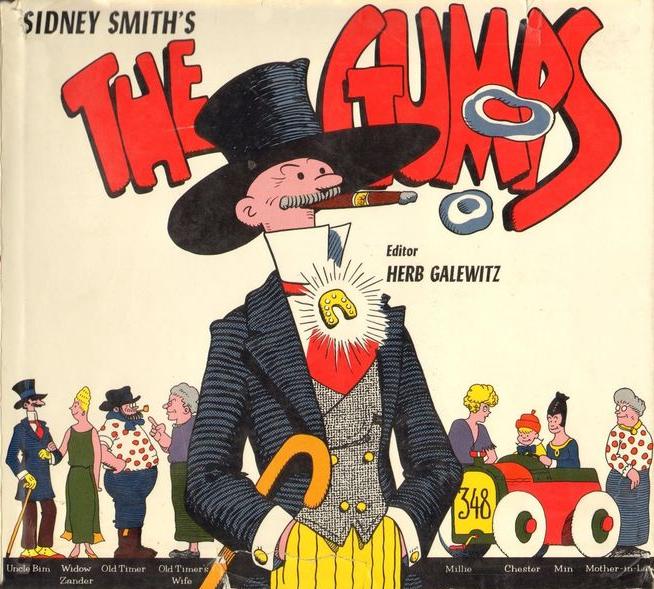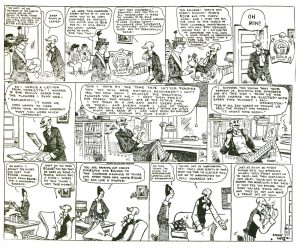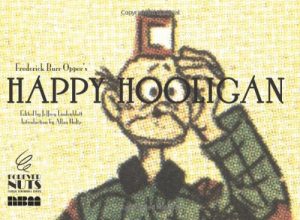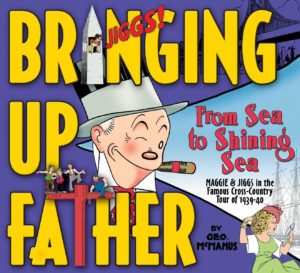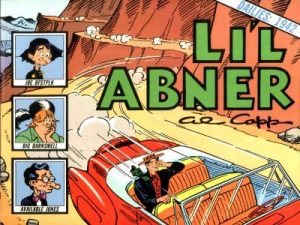Review by Win Wiacek
Chances are you’ve never heard of him, but Robert Sidney Smith is probably one of the most influential creators in the history of popular entertainment. A pretty big claim, but true nonetheless.
Smith was a pioneer of what we call continuity and the most successful early cartoonist to move newspaper strips on from situational, gag-a-day variations on a theme (a style that dominates again today) and build a relationship based on progress with his avid audience.
The Gumps is the ongoing saga of a middle class American family, which began in 1917 and ran for 42 years. It invited readers to share their largely comedic tribulations. Chinless wonder Andy Gump is a regular blowhard with lots of schemes to make his fortune, the formidable Min is shrewish and nagging, the boys are troublesome and Tilda is a nosy tartar. The domestic scene occasionally drifts into thrilling adventure and flights of fancy whenever eccentric, two-fisted globetrotting millionaire Uncle Bim pays a visit.
It sounds hackneyed now, but that’s because The Gumps wrote the book on what daily story narratives should be: a lot of laughs, plenty of vicarious judgement, the occasional tragedy, oodles of long-drawn out tension and characters everyone recognised if not actually identified with. It made Smith one the highest ever paid comic artists (allowing for inflation).
There will probably never be a comprehensive or complete Gumps collection, a pity as the art is still wonderful and most of the gags remain well-conceived and effective. The real problem is the pacing and verbosity of the text in the panels. That being the case, this monochrome landscape hardback from 1974 (254 x 231 x 23 mm) offers the best of all possible worlds; extracting salient snippets, events and extracts from key storylines whilst providing fascinating commentary and context where necessary.
Packed with photos and plenty of astonishing facts, Herb Galewitz’s introduction offers the run-down on the strip and its creator whilst also providing a glimpse at the star in the making.
Scenes of wedded bliss and domestic contention abound as Andy and Min contend with household chores, wayward furnaces, gardening, child-rearing and each other. As ticked off as they become, the happy marrieds seldom let their adversarial moments linger or fester. They take separate holidays in a 1922 sequence, the same year Andy runs for Congress. In 1929 series regular Mary Gold’s one true love is wrongfully convicted of robbery, and her subsequent death that year saw the story moved from the comics section to the Front Page. Readers registered their disapproval even as the sales of papers carrying the strip skyrocketed.
The longest reprinted sequence begins in 1933 when exotic Uncle Bim’s lady love becomes involved with an unscrupulous embezzler. Events encompass a hunt, a prospective wedding and a long-delayed happy ending of sorts in 1934.
These brief tastes of Smith’s amazing graphic narrative achievements are supplemented by a selection of shorter vignettes. They include an appreciation of a gag-panel displaying the oriental wisdom of “Ching Chow”. Although disquieting – if not actually disturbing – to modern eyes, this philosophy-spouting comedy Chinaman was crafted by a succession of creators and ran until June 4th 1990, outliving The Gumps by almost forty years.
Studious and genuinely enticing for students of the comic form and anybody interested in the development of both soap operas and sitcoms, this book provides insight and a fascinating visual tour of a phenomenon and world we’ve mostly outgrown, but one worth celebrating for all that.
